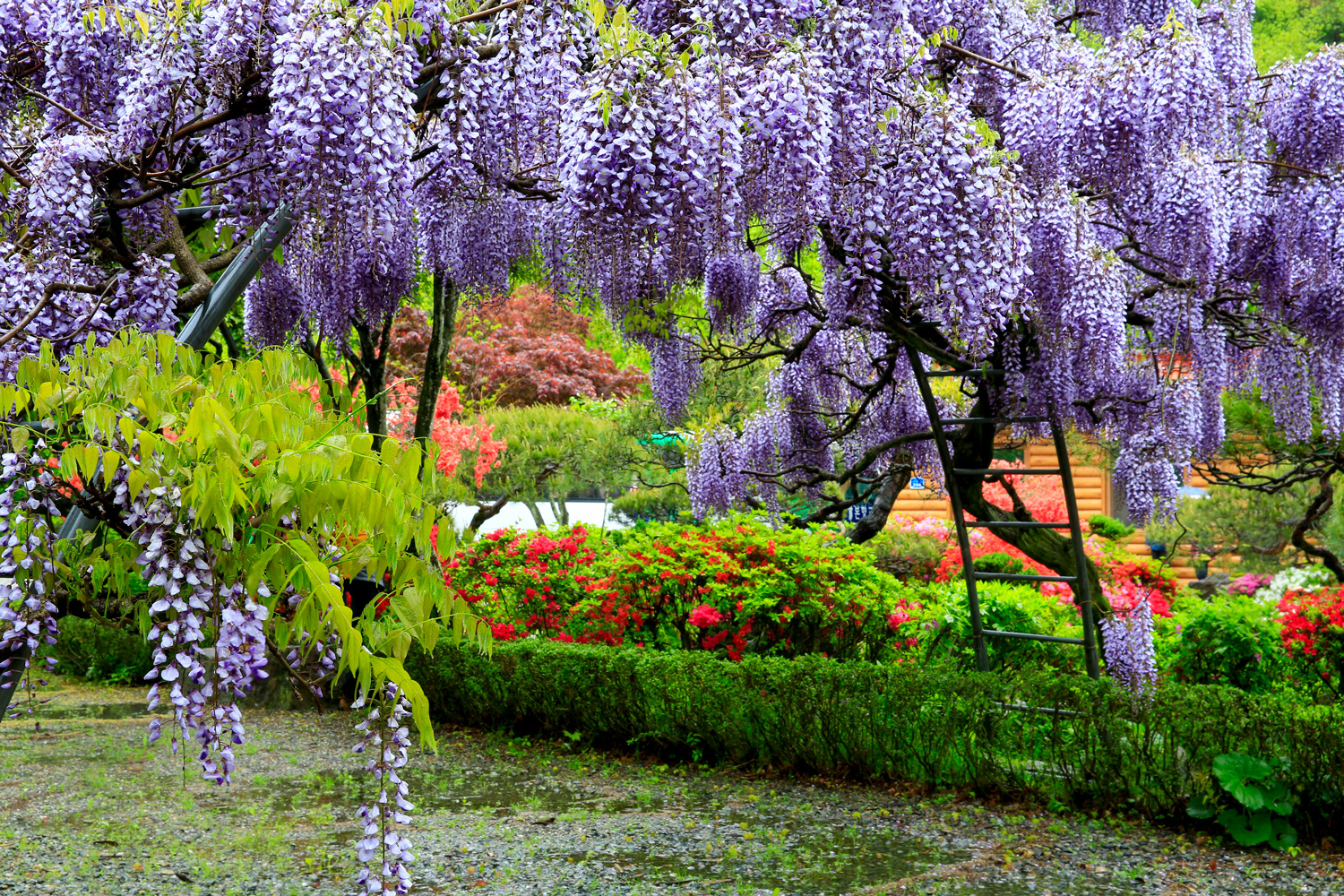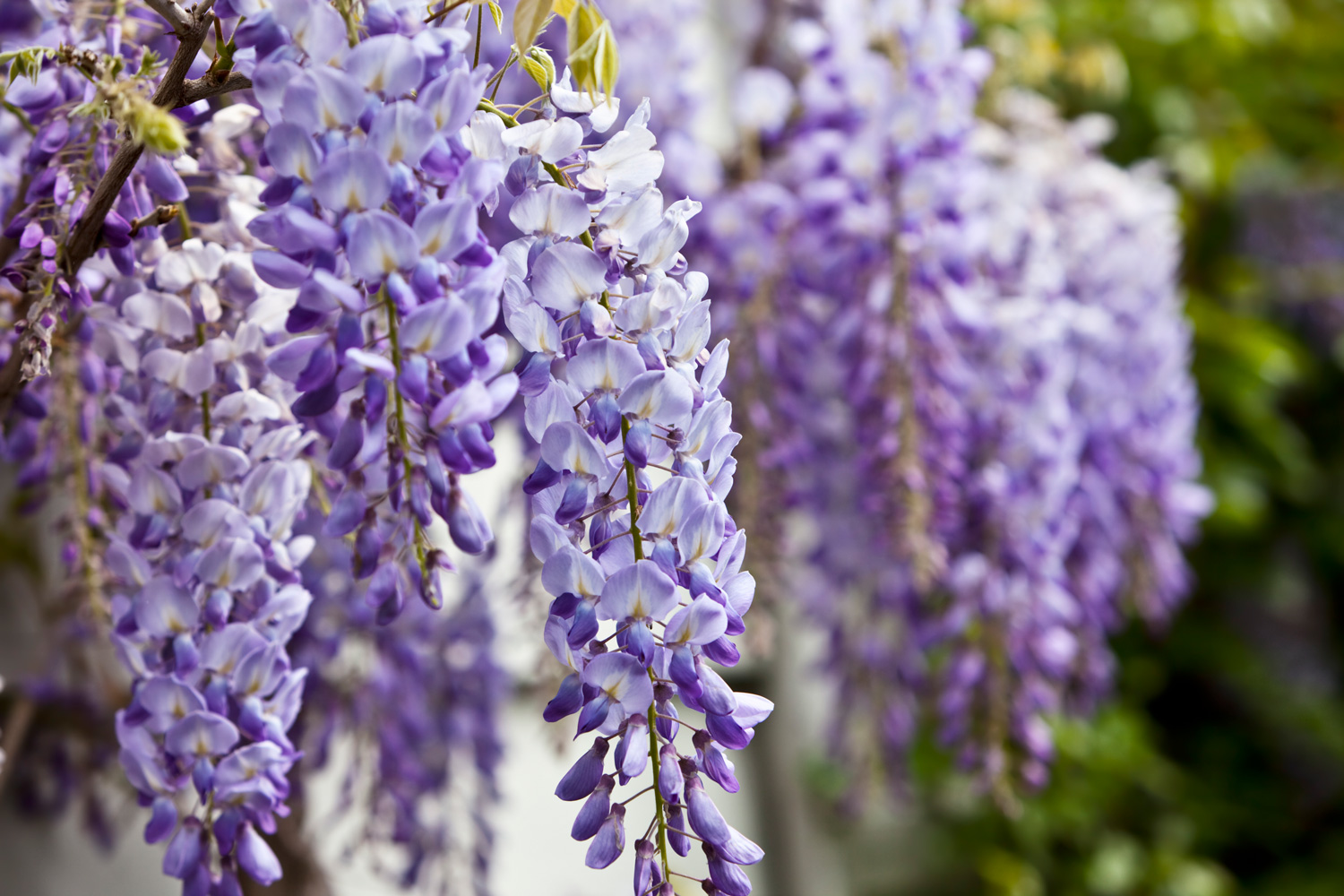Determining what type of plant you have growing in your landscape isn't always easy. Do you think you might have a wisteria vine or tree in your garden but can't tell the difference? Is there a difference between how a wisteria grows: vine or tree?
Well, we've done some digging and have these answers, among others, to share.
Between a wisteria vine and a tree, there is virtually no difference. Since wisteria is a deciduous vining plant, it is not considered a technical tree.
Therefore, if you have one growing in the shape of a tree or tall shrub, it is still a vining species. So, their only difference would be how you train them, not their genetic makeup.
As we start this article, we will cover all things wisteria and discuss the difference between a vine and a tree. Whether you're new to this species, have a few in your yard, or have other related questions, we're here to offer some help. With that said, let's dive right into this topic!

Is There A Difference Between A Wisteria Tree And Vine?
No, there is no difference between a wisteria growing as a vine and a tree. As we covered, wisteria is all classified as vining plants, so although you can train them vertically, they aren't a tree.
So, even if yours has a large base/stump and grows upwards, you still have it as a vine in technical terms. In addition, a wisteria will likely require training to grow as a tree or large shrub.
Therefore, you won't see one decide to become tree-like on its own. Experts claim that many wisterias can reach over 30 feet long or tall, depending on how you train them.
So, if you want a large flowering species for your landscaping: wisteria is a perfect choice.

You also want to note that wisterias are relatively heavy, so whatever structure you train them with has to manage large amounts of weight well.
What Is Wisteria Considered?
Wisteria plants are technically considered to be in the bean/pea family. Furthermore, wisteria is a vining plant, meaning they aren't trees or shrubs.
Wisteria is a genus of about 5-7 deciduous, woody vines belonging to the Fabaceae family. In addition, Fabaceae is the third-largest flowering plant family, with roughly 19,500 species.
So, in broader terms, wisteria is considered to be in the legume family. They also take on a more woodsy, twining vine growth pattern, which is why you can train them in different ways.
On top of that, wisteria or ornamental plants are mainly appreciated aesthetically rather than producing fruit or a usable crop.
How Do You Make A Wisteria Vine A Tree?
One of the best ways to train a wisteria as a tree is by creating a structure for it to grow in/on. Specifically, you can use a stake (like bamboo) in the soil around the wisteria.
If you start your plant young, this can result in a tree-like formation as it matures. Remember, wisteria are vines but can also be grown in shrub or tree form.
In addition, you can also train wisteria along a trellis, which will encourage vertical growth. Typically, vines grow up walls or nearby trees and structures, which could happen naturally in some cases.
However, you want to remember to keep your wisteria tree attached to its post until it's a few years old. That's because it will need a solid trunk to support its top.
As we mentioned, wisteria can become rather heavy, so a sturdy base is crucial.
Here's a YouTube video explaining this process from Gurney's Seed's official channel.
Jollybower Thicker Heavy-Duty Bamboo Stakes
These bamboo stakes work well for training trees, measure 84 x 4.5 x 1.5 inches, are 100% premium, natural bamboo, won't prick your fingers, come in various sizes, and include four stakes.
Follow this link to see them on Amazon.
How Big Will A Wisteria Vine Get?

You can usually expect a wisteria vine to reach 30 feet upon full maturity. However, some vines may only get ten feet long as they age, so this comes down to the plant.
As we covered above, wisteria is a relatively heavy, large vine. Therefore, where you plant, one can make a massive difference long-term.
According to Purdue University, wisteria requires support to become large. Generally, this species can't become 30+ feet without proper structural balance, starting at its base.
So, even if you don't want to train your vine as a tree: it still needs some base support.
For this reason, wisterias aren't always easy to grow and manage. For example, some gardeners witness significant annual growth in tree-trained wisteria, while others don't with vines.
Of course, that's not always 100% true, but in general, you want to train your wisteria.
How Fast Does Wisteria Grow?
Besides potentially growing heights of 30 feet, wisteria can hit this number within a few years. This flowering vine can grow upwards of ten feet yearly, which is insane.
As we mentioned, wisteria responds well to proper training, so if you grow them using a stake or trellis: expect significantly more growth each year.
One key takeaway is that your wisteria needs solid base support to grow rapidly. Even if you don't necessarily want a wisteria tree, training one vertically as a shrub can result in better growth.
So, a good compromise would be to train your wisteria vine more as a shrub than a ground cover. If not, you can expect your plant to grow around ten feet throughout its lifetime.
Furthermore, the sturdier and more developed a wisteria, the faster it grows.
Should I Train Wisteria Using A Trellis?

Yes! If you want your wisteria to grow big and tall, we recommend using a trellis. Typically, this vine responds better to structure versus moving vertically on its own, so having a surface for it to latch on to can make a big difference.
That said, trellises come in various shapes and sizes, so you don't always need a massive one for your wisteria. Especially if you prefer a smaller, more manageable plant, we recommend sticking with a shorter trellis design.
On top of that, it might be best to have your vine grow in the form of a shrub, which can make pruning and regular upkeep a bit easier.
Growing a tree can mean more thorough training and complicated pruning, which isn't for everybody. So, if you want to keep things simple, use a trellis: but one that will keep your wisteria a standard size.
Deaunbr Garden Plant Support Trellis
This trellis works well for vines, has a cage design, measures 11.9 x 11.9 x 63 inches, is sturdy, won't rust, has a durable plastic coating, and comes in a one or two-pack.
Check out this outdoor trellis on Amazon.
What Else Can You Use To Train Wisteria?
Your supporting structure might vary depending on how you want to train wisteria. People often use stakes or a trellis to train wisteria, although you can try and grow one on a nearby surface.
For example, many gardeners grow their wisteria on or over a fence or border wall. This can work as a sturdy place for your vine to latch onto and mature while also being gorgeous during the blooming season.
On top of that, you might choose to have your wisteria grow up a wall; in that case, you want to use strong, galvanized wires to climb. This doesn't always need to be complex.
Wisteria has a natural tendency to find a surface and make it its own, so your plant might not need much additional help.
However, planting one somewhere it can easily climb a surface is generally more beneficial than letting it fend for itself.
Like most vines, your wisteria won't like open land with nowhere to latch onto.
How Long Does Wisteria Live For?

Although this can vary by plant, wisteria typically lives for over 50 years. Many garden experts claim that wisteria is one of the older living vine species, which is excellent for those who prefer perennial plants.
Wisteria will generally thrive and live a long, healthy life if you have it somewhere with great soil and plenty of daily sunshine. Again, this can be iffy depending on the soil quality and how well you care for your plant, so everyone's different.
However, with a 40-50 year average, wisteria proves to be here for the long run. As we said earlier, your vine will also respond better to training and structure.
Therefore, if you want yours to live to be 50+ years old and grow big, we recommend a trellis or something along those lines.
Where Is The Best Place To Grow Wisteria?
When it comes to the "best" place to grow your wisteria, there are a couple of factors to meet. Usually, wisteria needs to grow in full sun to thrive and flower, so this is a top priority.
In addition, your vine will also need to be in fertile, moist, but well-draining soil.
If wisteria becomes waterlogged too often, there's a chance it will die. One thing you can do to improve soil quality and drainage is to add compost, so there are ways around this.
This species is pretty hardy, so don't be nervous about planting it if your garden isn't a perfect fit.
To Finish
Whether you have wisteria or want to grow one, it's always good to know how best to do this. We found that you can train wisteria as a tree, but it won't be classified as one.
There aren't any differences between a wisteria tree and a vine, as they're the same plant. The only difference is how you choose to train yours.
On top of that, it is beneficial to give wisteria some structure, so keep that in mind in your garden!
While we have you, check out these articles:
How To Know If Your Wisteria Is Dead
Does Wisteria Have Invasive Roots? [And How To Control Them]


